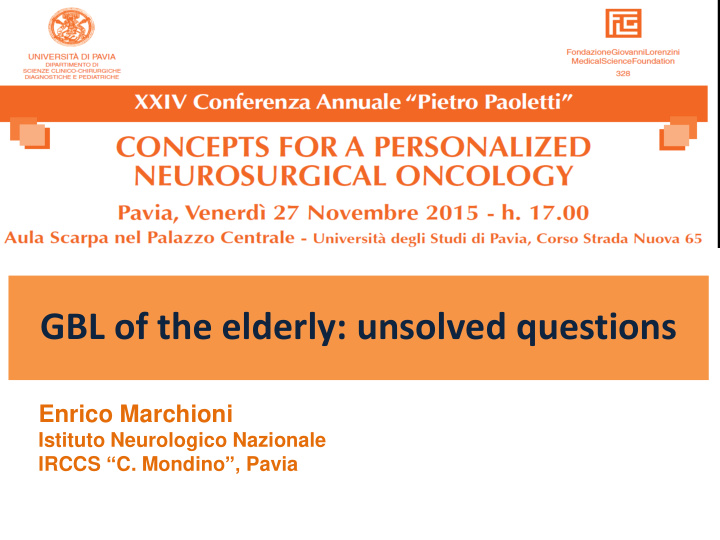



GBL of the elderly: unsolved questions Enrico Marchioni Istituto Neurologico Nazionale IRCCS “ C. Mondino ”, Pavia
GBL of the elderly: unsolved questions • Who’s elder? 65 or 70? functional status? comorbidity? • Stupp protocol: - not well tolerated in the elderly • temozolomide: - best choice in mMGMT+ ? • radiotherapy? - benefit or only morbidity? - standard vs hypofractionated
GBM of the elderly: the state of the knowledge The optimal therapeutic approach in elderly patients is of major interest as: - approssimately half of all patients with GBL are older than 65 - the incidence of GBL in the elderly population is increasing - many eldery individuals cannot tolerate combined therapy Combined treatment: the EORTC-NCIC trial confirmed significant improvements in OS, but: - these data offer little information regarding best practice for the treatment of the elderly pts with GBL - only a minority of patients enrolled in EORTC-NCIC trial were older than 65 yrs and patients older than 70 yrs were excluded
Our experience Last 45 pts > 60 yrs: Grade IV 5 myelosuppression unpublished 3 sepsis HSE encephalitis 2 published All patients stopped definitively the treatment
6 out 7 GBL patients develop HSE during or few weeks after Stupp protocol and 2 over 60 died of encephalitis Should acyclovir be added to the treatment protocol other than antibiotics?
412 pts >65 yo KPS>60 Temodal 100 mg/m2 7 day ON/7 day OFF vs RT 60 Gy Wick et al. Lancet Oncol 2012
> 70 yrs all 60-70 yrs
Stratified by MGMT promoter metylation status combined cht+rt temozolomide irrespective of treatments all groups
> 65 mMGMT+ mMGMT- TMZ TMZ + Hypofract. rt Hypofract. rt Individualized to the patient
Thanks for attention
Recommend
More recommend